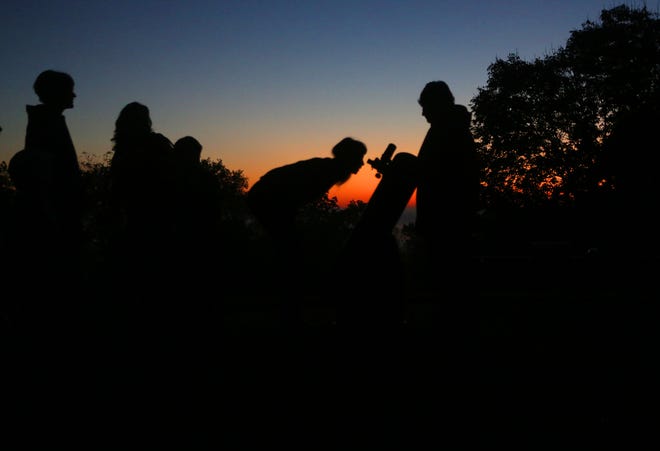
When you see the moon late at night on Sunday, May 15, you may notice something strange. Before midnight, it will look like someone has taken a curved bite out of the moon. It’s time again for a rare and awesome astronomical event: a total lunar eclipse. And it will be visible across most of the United States and the Western Hemisphere.

The full moon in May is also known as the Flower Moon, signifying the blooms that come with spring and appear in North America during the month. It has also been called the Planting Moon, Milk Moon or Hare Moon.
Here are some things you should know to be fully prepared and at-the-ready with quick facts to share with your friends and family.
What time does the total lunar eclipse start?
There are two really exciting moments during a lunar eclipse: When it first begins, and totality.
Just before a lunar eclipse starts, the moon will look like a normal full moon. If you are especially observant, you may notice a slight darkening or discoloration to the bottom left side of the moon around 10:20 p.m. Eastern Daylight Time (EDT). This is from the Earth’s lighter shadow, called the penumbra, that is barely visible to the naked eye. But this is a sign that the visible part of the eclipse is almost there.
The excitement will begin at precisely 10:27 p.m. when the first hint of the Earth’s darker shadow, called the umbra, appears on the disc of the moon. Look toward the bottom left side of the moon for a black dent, and then a definite arc of darkness will present itself. That is the rounded shadow of the Earth. If the moment strikes, you may howl!
Totality is totally worth it
Over the next hour, more and more of the lunar surface will plunge into darkness as the moon will slowly move into the Earth’s shadow. When the moon is totally in the Earth’s shadow, this is called a totality.
The moon will be in total eclipse for nearly 90 minutes: from 11:29 p.m. to 12:53 a.m. The moon won’t completely disappear during totality. Stray rays of sunlight will bend through the Earth’s atmosphere and weakly bathe the moon in warm light. During totality, the moon’s color will morph from eerie shades of gray to orange and even pink. The moon will look like a redder, dimmer shell of itself and often elicits the nickname of the Blood Moon for its temporary new color.
Kick back in a comfy chair and watch how the color changes from minute to minute.

Lunar Eclipse timing (Eastern Time)
- Partial lunar eclipse begins: 10:27 p.m.
- Total eclipse begins: 11:29 p.m.
- Deepest, darkest part of the eclipse: 12:11 a.m.
- Total eclipse ends: 12:53 a.m.
- Partial lunar eclipse ends: 1:55 a.m.
Why don’t eclipses happen more often?
To make a lunar eclipse, the sun, Earth and moon must be in almost-perfect alignment.
Sunlight travels about 93,000,000 miles to reach the Earth. Our planet then casts a long, skinny shadow into space. The moon, which is about 240,000 miles away, must travel into the very narrow shadow of the Earth.
But the moon orbits the Earth on a 5-degree slant. So only rarely does the moon pass through the narrow shadow of the Earth. The last lunar eclipse was on Nov. 19, 2021.
The ending, until next time
The eclipse will end when the Earth’s umbra finally leaves the lunar surface at 1:55 a.m. on the morning of May 16, and the moon will return to its full brilliance.
If you miss this eclipse or are clouded out, you will only have to wait another 177 days for the next one: coming on Nov. 9, 2022, when the sun, Earth and moon align once more.
Dean Regas is the Astronomer for the Cincinnati Observatory, and author of the books 100 Things to See in the Night Sky and How to Teach Grown-Ups About Pluto. He can be reached at [email protected].

Online Astronomy Classes
What: Want to learn astronomy from your own home? Join astronomer Dean Regas for these fast, fun and beginner classes on various topics in astronomy.
When: Before May 15: Get a recording of the Lunar Eclipse class. May 17: How to Teach Grown-Ups About Pluto. May 24: Best Astronomical Equipment.
Tickets: $10 per household.
More info: Classes are offered through a Zoom webinar and you get access to the recorded class to watch at your convenience; cincinnatiobservatory.org.
Source link





